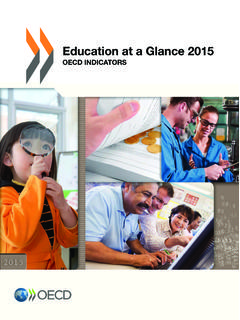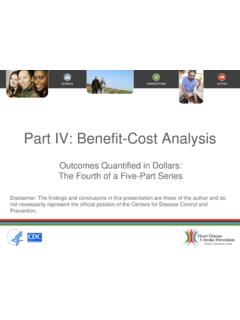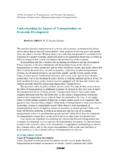Transcription of the economic value of social and emotional learning
1 February 2015 (Revised)Center for Benefit-Cost Studies in EducationTeachers College, Columbia for this research was provided by the NoVo Foundation ( ). the economic value of social and emotional learning Clive BelfieldBrooks BowdenAlli KlappHenry LevinRobert ShandSabine ZanderThe economic value of social and emotional LearningClive Belfield, Brooks Bowden, Alli Klapp, Henry Levin, Robert Shand and Sabine ZanderCenter for Benefit-Cost Studies in EducationTeachers College, Columbia 2015 (REVISED VERSION)Funding for this research was provided by the NoVo Foundation ( ).Acknowledgements: The authors greatly appreciate comments and support from Steve Aos, John Bridgeland, Mark Greenberg, Damon Jones, Stephanie Lee, Annie Pennucci, and Roger Weissberg. the economic value of social and emotional learning 3 SummaryBenefit-cost analysis is a tool for evaluating the economic profitability of an investment .
2 It has been used in education since the 1960 s to determine the rate of return on both individual and social investments in education. Essentially, benefit-cost analysis compares the monetary cost of an investment with the monetary value of its outcomes. For example, by reducing high school dropouts there are costs to the student in foregone income by staying out of the labor market. But there are also gains to the student in terms of higher income, better health, and lower likelihood of involvement in the criminal justice system, all which can be measured, in terms of a monetary return on investment . The taxpayer also makes an investment in education through paying a considerable portion of its direct cost and gets a return through higher tax revenues and lower costs of public services for health, public assistance, and criminal justice. And, society obtains returns by using its resources in its most pro-ductive ways, at least partially reflected in economic is not necessarily the case that the benefits of an educational investment always justify the costs.
3 For some interventions, the benefits will exceed the costs. But in others the investment is not found to be compensated by its returns: even if an intervention is effective, it may be too expensive to implement. Thus, the purpose of a benefit-cost (BC) study is to provide an accurate measure of costs and benefits to determine not only if the benefits are greater than the costs of the investment , but by how much. In the educational setting, we seek investments that have the highest return to the taxpayer and to society. In the past, BC studies have been limited largely to increases in educational attainment and to improvements in cognitive test scores. But it is now becoming widely recognized that social and emotional learning in schools can be as important as or even more important than cognitive gains in explaining important developmental and life outcomes (Durlak et al.)
4 2011; Heckman and Kautz 2012; Levin 2012). social and emotional skills are less commonly considered in educational evaluations, in part because they are more challenging to measure than attainment and test scores. As such skills have gained prominence, it is important to integrate them into BC studies for consideration in educational policy and of the long history of the Center for Benefit-Cost Studies in Education (CBCSE) at Teachers College and its predecessor organizations in publishing BC studies in education ( Levin 1975, Levin and McEwan 2001, and other publications at ), it was requested by the NoVo Foundation and the Collaborative for Academic, social , and emotional learning (CASEL) to apply BC analyses to studies of social and emotional learning . The purpose was to both demonstrate the BC method in this domain as well as to gain early perspectives on the potential economic returns to investments in social and emotional this Report, we review the available evidence on the economic value of social and emotional learning (SEL).
5 We utilize a formal method to perform economic valuations with respect to changes the economic value of social and emotional learning 4 in social and emotional (SE) skills to guide future evaluations of reforms that target SEL. Our main contribution is to demonstrate BC analysis using recent impact evaluations of six prominent SE intervention: 4Rs; Positive Action; Life Skills Training; Second Step; Responsive Classroom; and social and emotional Training (Sweden).Table S1 social and emotional learning InterventionsInterventionGrades and Student Groups4 RsLearning and literacy program to combat aggression/violenceGrades K 5 DisadvantagedPositive ActionSchool curriculum/activities to promote positive thinking, actions, and self-conceptGrades 3 8 AllLife Skills TrainingClassroom intervention to reduce substance abuse/violenceGrades 6 12At-risk studentsSecond StepSocial skills curriculum to improve problem-solving/ emotional managementGrades PK 10 DisadvantagedResponsive ClassroomImprove teacher efficacy to influence SE skills and school communityGrades 3 5 AllSocial and emotional Training (Sweden)Classroom intervention to support cognitive and SE competenciesGrades 1 9 All Table S1 provides the descriptions of the six interventions.
6 These interventions were chosen because they are prominent in the literature and provide diversity in terms of their goals, measures of outcomes, and student populations. For each intervention we have constructed tables of ingredients and their costs; alongside, we have created benefit maps to sum-marize the possible benefits each intervention might confer and calculated the monetary value of the portion of benefits that could be identified and quantified based on the results reported in the impact evaluation. We then computed appropriate economic metrics benefit-cost ratios and net present values and performed sensitivity testing to see if the results are robust to alternative specifications. Our central question is whether a range of different SEL interventions, both individually and in the aggregate, show benefits that exceed their costs. We recognize the fact that we have captured only a portion of their benefits because not all of their effects are fully measured and can be readily con-verted into monetary measures of their benefits.
7 Further, the portion of benefits that we have been the economic value of social and emotional learning 5 able to capture may differ considerably among the different interventions depending upon the goals of each and measurability of the associated benefits. We caution that it is inappropriate to compare indi-vidual benefit-cost ratios among the six interventions in the absence of a more complete accounting of benefits for each. Thus, we focus primarily on the basic question of whether the available measures of benefits are equal to or exceed costs for each and summarize our results with an overall average benefit-cost ratio among the six interventions. The most important empirical finding is that each of the six interventions for improving SEL shows measurable benefits that exceed its costs, often by considerable amounts. There is a positive return on investments for all of these educational reforms on social and emotional learning .
8 And the aggregate result also shows considerable benefits relative to costs, with an average benefit-cost ratio of about 11 to 1 among the six interventions. This means that, on average, for every dollar invested equally across the six SEL interventions, there is a return of eleven dollars, a substantial economic return. These findings are robust to the imposition of different assumptions on the sources and construction of benefits and costs, and a full accounting for benefits, as shown in the benefit maps, would provide an even larger return. However, we emphasize that in addition to the benefit-cost test that we have imposed on these interventions, an important contribution of this report is its demonstration of methods and appli-cations to estimating benefits and costs of SEL interventions. Only if a formal method is applied in a transparent way will economic evaluations of SEL interventions help improve resource allocation within the school setting.
9 This methodological demonstration can advance understanding of SEL in the future. Because our calculations have not captured all of the benefits of each of the interventions and the proportions that we have captured probably vary considerably among them, we caution the reader that it is inappropriate to compare directly the results for specific interventions relative to the others. The important findings are that each of the SEL approaches shows benefits that exceed costs and that the average return is very high, but differences in the quality and availability of comparable data preclude precise comparisons among the interventions for the following reasons: Evaluation Quality We drew upon the best evaluations for each intervention that were available. However, even among relatively high quality evaluations there was variation. Had the evaluation designs and measurements been of consistent quality, there might have been some differences in results.
10 Both data quality and research methods account for some potential differences in our results. Cost Estimation Our cost method is the well-established ingredients method, which requires iden-tification of all of the resources that were required to produce the results that were found in the evaluations. Since all evaluations had been done in the past, it was necessary to reconstruct the inter-ventions as they had been implemented at the time of their reported effectiveness results. Precise details of the interventions were rarely available, and attempts to contact informed observers were not always successful. Even when successful, relying on retrospection of details can often provide incomplete or misleading results. To as great an extent as possible we have attempted to use multiple sources to construct the cost estimates, but differences in the information base attainable for each of the interventions varied considerably in comprehensiveness and quality.






